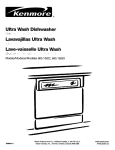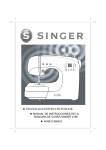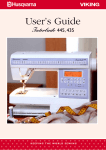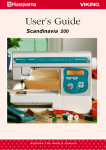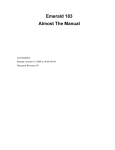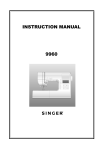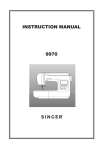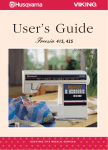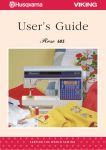Download Baby Lock Audrey BL67 Instruction manual
Transcript
IMPORTANT SAFETY INSTRUCTIONS When using an electrical appliance, basic safety precautions should always be followed, including the following. Read all instructions before using this sewing machine. DANGER - To reduce the risk of electric shock: 1.This sewing machine should never be left unattended when plugged in. Always unplug this sewing machine from the electric outlet immediately after using and before cleaning. 2.Always unplug before replacing light bulb. Replace bulb with same type rated 1 watts. WARNING - To reduce the risk of burns, fire, electric shock, or injury to persons: 1.Do not allow to be used as a toy. Close attention is necessary when this sewing machine is used by or near children. 2.Use this sewing machine only for its intended use as described in this manual. Use only attachments recommended by the manufacturer as contained in this manual. 3.Never operate this sewing machine if it has a damaged cord or plug, if it is not working properly, if it has been dropped or damaged, or dropped into water. Return the sewing machine to the nearest authorized retailer or service center for examination, repair, electrical or mechanical adjustment. 4.Never operate the sewing machine with any air openings blocked. Keep ventilation openings of the sewing machine and foot control free from the accumulation of lint, dust, and loose cloth. 5.Never drop or insert any object into any opening. 6.Do not use outdoors. 7.Do not operate where aerosol (spray) products are being used or where oxygen is being administered. 8.To disconnect, turn switch to the off position, then remove plug from outlet. 9.Do not unplug by pulling on cord. To unplug, grasp the plug, not the cord. 10.Keep fingers away from all moving parts. Special care is required around the sewing machine needle. 11.Never sew with a damaged needle plate as this can cause needle to break. 12.Do not use bent needles. 13.Do not pull or push fabric while stitching. It may deflect the needle causing it to break. 14.Switch the sewing machine OFF when making any adjustments in the needle area, such as threading needle, changing needle, threading bobbin, or changing presser foot, etc. 15.Always unplug sewing machine from the electrical outlet when removing covers, lubricating, or when making any other user servicing adjustments mentioned in the instruction manual. CAUTION- Moving parts - To reduce risk of injury, switch off before servicing. Close cover before operating machine. SAVE THESE INSTRUCTIONS This product is for household use, or equivalent. FOOT CONTROL (USA ONLY) ELECTRONIC MODEL Use Matsushita Electric, Model YSD180034 with this sewing machine. POLARIZED PLUGS CAUTION This appliance has a polarized plug (one blade wider than the other). To reduce the risk of electric shock, this plug is intended to fit in a polarized outlet only one way. If the plug dose not fit fully in the outlet, reverse the plug. If it still does not fit, contact a qualified electrician to install the proper outlet. Do not modify the plug in any way. CONTENTS IMPORTANT SAFETY INSTRUCTIONS CONTENTS MAIN PARTS 1 2 ACCESSORIES 4 OVERCASTING-OVERLOCKING 21 USING THE OVERCASTING FOOT 21 USING THE GENERAL PURPOSE FOOT 21 22 EXTENSION TABLE / ACCESSORY STORAGE 4 BLIND HEM STITCHING REMOVING THE EXTENSION TABLE 5 5 BUTTONHOLE SEWING 5 MULTI-STITCH ZIGZAG 25 6 ELASTIC STITCH SEWING 25 6 STRAIGHT STITCH SEAMING AND QUILTING 26 OPENING THE ACCESSORY STORAGE TOTE BAG CHANGING THE PRESSER FOOT REMOVING THE PRESSER FOOT HOLDER INSERTING THE NEEDLE CONNECTING THE MACHINE CONTROL BUTTONS & DROP FEED LEVER CORDED BUTTONHOLES 23 23-24 24 6 STRAIGHT STITCH SEAMING 26 7 8 QUILTING 26 FEED DOG CONTROL 26 START/STOP BUTTON 8 SLIDE SPEED CONTROL LEVER 8 PATCH WORK 27 LOW SPEED BUTTON 8 8 8 APPLIQUE INSERTING ZIPPERS AND PIPING PIPING SCALLOP STITCH 27 REVERSE STITCH BUTTON NEEDLE UP / DOWN BUTTON DROP FEED LEVER READY INDICATOR DIRECT SELECT BUTTONS REINFORCEMENT BUTTON FOOT CONTROL CONTROL BUTTON FUNCTIONS STITCH SELECTION SETTING THE STITCH WIDTH AND STITCH LENGTH VARIOUS NEEDLE POSITIONS BOBBIN WINDING REMOVING THE BOBBIN WINDING THE BOBBIN INSERTING THE BOBBIN THREADING THE MACHINE 8 8 8 8 9 9 10 10 10 11 11 11 12 13 NEEDLE THREADER 14 DRAWING UP THE BOBBIN THREAD 14 16 TURNING CORNERS 16 SEWING HEAVY FABRIC 16 SEAMING GUIDE ON THE STITCH PLATE 16 ADJUSTING THE THREAD TENSIONS 17 FABRIC, THREAD AND NEEDLE TABLE 18 ZIGZAG STITCH SEWING SATIN STITCHING or APPLIQUE FREE ARM SEWING DECORATIVE SCALLOP EDGE ADJUSTING DECORATIVE PATTERNS 26 28 28 29 29 29 29 SEWING LIGHTWEIGHT FABRICS 29 CARING FOR YOUR MACHINE 30 CLEANING THE FEED DOGS AND HOOK AREA HELPFUL HINTS BL67 -STITCH CHART CONVERSION ACTION BEEPS 15 REVERSE STITCHING STRAIGHT STITCH SEWING SCALLOP HEM 13 THREADING THE UPPER THREAD STARTING TO SEW DARNING 19 20 20 20 -1- 30 31 32 32-35 35 MAIN PARTS 17 16 15 14 13 12 1 2 3 11 10 9 4 5 6 18 19 8 7 1.Face Cover 10.Pattern selector button 2.Needle Up / Down button 11.Stitch width button 3.Reverse Stitch button 12.Handwheel 4.Low speed button 13.Bobbin winder stop 5.Thread cutter 14.Bobbin winder shaft 6.Start / Stop button 15.Horizontal spool pin 7.Extension table / Accessory Storage 16.Thread Tension Dial 8.Slide speed control lever 17.Bobbin winder tension disc 9.Stitch length button 18.Direct select buttons 19.Reinforcement button -2- 21 20 27 22 26 23 25 24 20.Carrying Handle 21.Thread guide for upper threading 22.Power switch 23.Air vent 24.Foot control plug 28 25.Plug socket 26.Power cord 29 27.Foot control 28.Lower thread guide 30 29.Needle threader lever 30.Needle threader 31 31.Buttonhole lever 32.Presser foot thumb screw 32 33.Needle plate 34.Bobbin cover 33 35.Bobbin cover release lever 36.Presser foot holder 34 37.Presser foot 38.Needle thread guide 39.Needle clamp screw 40.Presser foot lever 41.Drop feed lever 40 39 38 37 36 35 41 -3- ACCESSORIES Some accessories are provided in the accessory case. 1.Needle Set 2.Bobbins 3.Spool pin cap (large) 4.Spool pin cap (small) 5.Needle plate screwdriver 6.Screwdriver 7.Seam ripper / buttonhole cutter / lint brush 8.Buttonhole foot 9.Overcasting foot 10.Zipper foot 11.Blind hem foot 12.Straight stitch foot 13.All purpose foot (on machine) 14.Open toe foot 15.Darning foot 9 16.1/4 inch foot 17.Tote bag 12 13 1 2 3 5 4 6 7 8 11 10 17 14 15 EXTENSION TABLE / ACCESSORY STORAGE Accessories can be stored in the extension table. -4- 16 a. REMOVING THE EXTENSION TABLE Hook your finger in the bottom of extension table and slide to the left. To attach, position and slide to the right. b.OPENING THE ACCESSORY STORAGE To open the accessory storage box, remove extension table from machine and open as illustrated. TOTE BAG Unzip the tote bag for storing or carrying the machine. -5- CHANGING THE PRESSER FOOT The presser foot must be changed according to the stitch you sew, or work you do. CAUTION:To prevent accidents. Turn OFF the power switch before you change the presser foot. 1.Turn the handwheel toward you until the needle is at its highest position. 2.Raise the presser foot lifter. 3.Remove the presser foot by pushing the presser foot release lever toward you. 4.Place desired foot with its pin A directly under the slot B in presser foot holder. 5.Lower the presser foot lifter and the presser foot will snap into place. 2 5 3 REMOVING THE PRESSER FOOT HOLDER You may need to remove the presser foot holder to use some presser feet. To remove, raise the presser foot lifter and loosen the presser foot thumb screw (C). To attach, tighten the screw after raising the presser foot holder. 1 A C B 4 A Presser foot pin B Presser foot holder slot C Presser foot thumb screw INSERTING THE NEEDLE Select a needle of the right type and size for the fabric to be sewn. (See Fabric, Thread and Needle Table on page 18.) CAUTION:To prevent accidents. Turn OFF the power before removing the needle. 1.Turn the handwheel toward you until the needle is at its highest position. 2.Loosen the needle clamp screw. 3.Remove the needle. 4.Insert new needle into needle clamp with the flat side to the back and push it up as far as it will go. 5.Tighten the needle clamp screw. 2 1 3 A.Place needle on a flat surface and check to see if bent. Do Not use any bent or dull needles. 5 4 A -6- CONNECTING THE MACHINE Place the machine on a stable table. POLARIZED PLUG INFORMATION 1.Connect the power cord to the machine by inserting the 2-hole plug into the plug socket. 2.Connect the power cord plug to the electric outlet. 3.Turn the power switch. 4.A lamp will light up when switch is turned on. This appliance has a polarized plug (one blade wider than the other). To reduce the risk of electric shock, this plug is intended to fit in a polarized outlet only one way. If the plug does not fit fully in the outlet, reverse the plug. If it still does not fit, contact a qualified electrician to install the proper outlet. Do not modify the plug in any way. 5.To disconnect, turn the power switch to the position, then remove plug from outlet. 5 3 O F F O N 1 2 DANGER: -To reduce the risk of electric shock. Never leave the machine unattended when plugged in. Always unplug this machine from the electric outlet immediately after using and before maintenance. WARNING: -To reduce the risk of burns, fire, electric shock, or injury to persons. Do not unplug by pulling on the cord. To unplug, grasp the plug, not the cord. -7- CONTROL BUTTONS & DROP FEED LEVER A.START / STOP BUTTON The machine will start running when the START / STOP button is pressed and will stop when pressed the second time. The machine will sew slowly the first 3 stitches sewn. B.SLIDE SPEED CONTROL LEVER When using the START / STOP button, the machine will sew faster when the slide speed control lever is moved to the right, and sew slower when the lever is moved to the left. C.LOW SPEED BUTTON The machine will sew in low speed while holding the low speed button. Press the START / STOP button or foot control to return toregular speed. D.REVERSE STITCH BUTTON Stitches 1, 2 and 6: The REVERSE STITCH button will sew in reverse while the button is pressed and return to forward stitching when the button is released. Other stitches: The REVERSE STITCH button will sew 3-4 stitches to tie-off the stitching and then stop sewing. Continue sewing by pressing the START / STOP button or foot control. E.NEEDLE UP / DOWN BUTTON When the presser foot is down, the needle can be raised or lowered by pressing this button. When the presser foot is up, press this button for one complete stitch. F.DROP FEED LEVER The feed dogs project up through the needle plate, directly below the presser foot move the fabric being sewn. Located under the left end of the free arm, the drop feed lever moves the feed dogs into the up or down position. For darning or free motion embroidery or whenever fabric is to be fed by hand, push the lever in and to the back of machine to lower the feed dogs into the DOWN position. For return to ordinary sewing, move the lever in and forward to release the lever to move out. This will position the feed dogs in the UP position for machine feeding. G.READY INDICATOR Green light indicates that the machine is ready to sew. Red light means an additional step is needed before beginning to sew. See instructions for the specific stitch selected. H.DIRECT SELECT BUTTONS Press one of the seven lighted buttons to quickly select one of the most often used stitches (For other stitches, refer to page 10). I.REINFORCEMENT BUTTON Stop the machine and press this button to sew 4 stitches and tie-off your stitching. C D E G H A I F B -8- FOOT CONTROL Use of foot control will permit control of start, stop and speed with your foot. CAUTION: To prevent accidents. 1.Turn OFF the power switch. 2.Push foot control plug into receptacle on machine. 3.Place foot control at your feet and turn ON power switch. Sew faster by increasing the pressure on the foot control. To stop, remove your foot from the foot control. C A O F F O N B CONTROL BUTTON FUNCTIONS SAFETY FEATURE OF ELECTRONIC MODEL Some control button functions described in If the machine is jammed, it will stop with three previous page will change when the foot beep sounds. After the cause of jamming is control is connected. removed, step on the foot control and it will run in normal condition. A.START/STOP BUTTON This button will be deactivated. B.SLIDE SPEED CONTROL LEVER This button is not operable when foot control is used. C.REVERSE STITCH BUTTON When using stitches 1,2, and 6,the machine will continue to sew reverse at slow speed while this button is pressed. When released, the machine will sew forward. When sewing other stitches, the reverse stitch button is used as tie-off. WARNING: -To reduce the risk of burns, fire, electric shock, or injury to persons. 1.Handle the foot control with care and avoid dropping it on the floor. Be sure not to place anything on top of it. 2.Use only foot control provided with this machine. -9- STITCH SELECTION 01. STRAIGHT STITCH 02. LEFT POSITION, STRAIGHT STITCH 03. QUILT STITCH, LIKE HAND SEWN 04. TRIPLE STRAIGHT STITCH 05. STEM STITCH FOR STRETCH FABRICS 06. ZIGZAG STITCHING 07~14. BUTTONHOLES 15. 3-STEP ZIGZAG 16. SATIN STITCH 17. RICK-RACK 18. OVERLOCK 19. DOUBLE OVERLOCK 20. SHELL 21. BLIND HEM 22. STRETCH BLIND HEM 23. DOUBLE ACTION 24. BRIDGING 25. FEATHER 26. FEATHER 27~66. DECORATIVE AND FUNCTIONAL STITCHES 01 02 03 04 05 06 07 08 09 10 11 12 13 14 15 16 17 18 19 20 21 22 23 24 25 26 27 28 29 30 31 32 33 34 35 36 37 38 39 40 41 42 43 44 45 46 47 48 49 50 51 52 53 54 55 56 57 58 59 60 61 62 63 64 65 66 SETTING THE STITCH WIDTH AND STITCH LENGTH Preset stitch length and stitch width are indicated by the number of LED lights. The longer or wider the stitch length/stitch width is, more of the LED lights are on. Some stitches have a blinking light which indicates the setting between two LED lights. Adjust the stitch width by pressing B button. For wider stitch width, press button to get more LED lights displayed. For narrower stitch width, press button past five LED lights till one is lit and then continue. 15 _ A + B C For longer stitch length, press the button (A) to get more LED lights. For shorter stitch length, press the button to get all five LED lights displayed, then press the button again till one LED is displayed and so on. To select pattern Pattern button C is to select the pattern desired. Press + button, you get higher number of the pattern. _ Press button, you get the lower number of the pattern. Example LED indicating 15 + button, you get No.16,17 and so on. Press Press _ button, you get No.14,13 and so on. VARIOUS NEEDLE POSITIONS When straight stitch pattern 01 has been selected, stitch width button B may be used to adjust the needle position. For stitch length and stitch width of each pattern, refer to table on page 32 through 35. -10- BOBBIN WINDING REMOVING THE BOBBIN 1 2 1.Remove the bobbin cover by sliding the release lever to right and push down the left corner of bobbin cover at the same time. 2.Remove the bobbin from the machine. WINDING THE BOBBIN 1 2 4 3 5 1.Raise presser foot lever. Pivot spool pin into highest position. Place a spool of thread on the spool pin. Secure it with the spool cap to ensure smooth flow of thread. Use a spool cap closest in size to the spool of thread being used. 2.Pass thread from spool through thread guides as shown. 3.Pull end of thread through hole in bobbin as shown. 4.Move bobbin winder shaft to the left. Place bobbin onto shaft and rotate till it snaps into position with the end of thread coming from top of bobbin. Push bobbin winder shaft to right until it clicks. Hold onto end of thread. 5.Start machine to wind the bobbin. Stop machine after a few turns to trim the thread tail with scissors. Bobbin will stop turning when completely filled. Cut the thread and push shaft to the left to remove bobbin. -11- INSERTING THE BOBBIN 1. Place bobbin into bobbin holder with the 1 thread unwinding counter clockwise. 2. Draw thread into notch (A). 2 A 3. Pull thread toward the left and along the inside of spring (B) until it slips into notch (C) being sure that thread does not slip out of notch (A). 3 C B A C B 4. Pull thread out about 10 inches and replace the bobbin cover by inserting the left side and lowering the right side till snaps into position. -12- 4 A THREADING THE MACHINE THREADING THE UPPER THREAD 2 1 1. Raise presser foot lever.up position. 2. Press the needle up / down button or rotate the handwheel toward you to raise the needle into the up position. 3. Place a spool of thread onto the spool pin and secure with the proper size spool cap (see page 11). 4. Pass the thread into the thread guide for upper threading and snap forward between the thread guide and guide plate. 5. Bring thread forward down the right channel, then to the left and up the left channel. 6. Pull the thread into the take-up lever from right to left and pull thread forward. 7. Pass the thread down the left channel and into the thread guide at the base of the face cover from right to left. 8. Pass the thread from right to left into the thread guide on the needle clamp. 9. Thread the needle from front to back or follow directions for needle threader on next page. 4 4 6 6 7 5 7 8 8 5 9 -13- 9 NEEDLE THREADER 1.Lower the presser foot. 2.Set needle in up position. 3.Lower the threader slowly and draw thread through thread guide (A) and pull toward the right. 1 2 3 A 4.Lower the lever as far as it will go The threader will turn and the hook pin will go through the needle eye. 5.Position thread below the needle eye and under the hook pin. 5 4 6.Hold thread loosely and slowly return lever to original position. Hook will turn and pass thread through needle eye while making a loop of thread. 7.Raise presser foot and pull thread out about 10 inches from needle eye. Note: The needle threader can only be used for needle sizes 11,14, and 16. 6 7 CAUTION: To prevent accidents. Do not lower the threader lever while machine is operating. DRAWING UP THE BOBBIN THREAD 1 2 1.Raise the presser foot. 2.Hold the upper thread loosely and press needle up/down button. The handwheel will turn one complete turn. 4 3.Pull upper thread lightly. Bobbin thread will come up in a loop. 4.Pull both upper and bobbin threads about 10 inches toward the back and under the presser foot. -14- 3 STARTING TO SEW The machine will be set at 01 automatically to sew straight stitches when power switch is turned on. CAUTION:To prevent accidents. While sewing, special care is required around the needle. The machine will automatically feed the fabric, do not pull or push fabric. Simply guide the fabric to sew straight. 6 3 4 7 1 2 5 8 1. Check the presser foot (All Purpose Presser Foot is on new machine.) Refer to page 6 for changing the presser foot. 2. Place the fabric under the presser foot. 3. Lower the presser foot. 4. Hold both threads to the back when starting to sew. Let threads go after sewing a few stitches. 5.While sewing regulate the speed with slide speed control lever or foot control. 6.Stop machine when you reach end of seam. 7.Raise the presser foot lever. 8. When you have reached the end of a seam, stop sewing and turn the handwheel toward you to bring the needle to highest position. Raise the presser foot and pull the fabric out from under the foot to the back of the machine. Cut the threads in the thread cutter on the left side of the machine. -15- REVERSE STITCHING 2 Reverse stitching is used for reinforcing the ends of the seams. 3 1 1.Place the fabric in position where back stitching is to be made and lower the presser foot. 2.Press reverse stitch button and sew 4-5 stitches. (If using the foot control, press pedal while pressing reverse stitch button.) 3.Press start button and resume sewing. (If using the foot control, release reverse stitch button and press foot control to sew forward.) 4.When you reach the end of seam, press reverse stitch button and sew 4-5 reverse stitches. 4 TURNING CORNERS 5 1.Stop the machine when you reach a corner. 2.Lower needle into the fabric. To lower the needle, you can either use the needle up/down button or turn the handwheel toward you. 3.Raise the presser foot. 4.Use the needle as a pivot and turn fabric. 5.Lower the presser foot and resume sewing. 2 3 1 4 SEWING HEAVY FABRIC When sewing heavy fabrics, the toe end of presser foot tends to lift up and sewing will hesitate at the point that the fabric is thicker. In this case, place a piece of cardboard or fabric of same thickness under the heel end of the presser foot. The presser foot lever can be raised 1 step higher for placing heavy materials under the presser foot easily. A Carefully guide the fabric with your hand when sewing over thick fabric areas. A: Fabric A B: Thick paper or fabric B SEAMING GUIDE ON THE STITCH PLATE The figure on each guide line on the stitch plate indicates the distance between this guide line and the center needle position. Guide the fabric along the specific guide line in order to get the desired seam allowance between the stitching and the edge of the fabric. 1/2 5/8 3/4 7/8 10 15 20 25 -16- ADJUSTING THE THREAD TENSIONS The thread tension must be properly balanced. If adjustment is required, it can be made by changing the upper thread tension. A 5 4 3 4 3 A. Correct Thread Tension Upper and bobbin threads should interlock in the middle of fabric. B.When bobbin thread appears on top side of fabric. B 5 Turn the tension dial to a lower number to loosen the upper thread tension. TOP BOTTOM C C.When upper thread appears on the bottom side of fabric. 5 Turn the tension dial to a higher number to tighten the upper thread tension. 4 3 TOP BOTTOM D.Thread Tension for Zigzag Stitches D To sew zigzag stitches, the thread tension should be set to a slightly weaker tension than when sewing straight stitches. You will obtain a nicer stitch when upper thread appears slightly on bottom side of fabric. -17- BOTTOM TOP Helpful Hint When stitches on top side of fabric are good but bottom side tends to have a bunch of thread (as illustrated), the upper thread is not threaded correctly, especially in the upper thread tension area. Refer to page 13 and rethread machine correctly. CAUTION:To prevent accidents. The feed dog will feed the fabric automatically. Do not pull or push fabric with hands. This could cause needle breakage or poor quality stitches. FABRIC, THREAD AND NEEDLE TABLE Select size of thread and needle according to the fabric to be sewn. Type of Fabric Thread Size Needle Size Light Weight-thin georgette, organdy, viole, taffeta, silk, etc. Ctn.# 80 - 100 Silk 60 - 80 Syn. 80 - 100 Medium Weight-gingham, pique, linen, cotton, satin, thin corduroy, velvet Ctn.# 50- 80 Silk 50 Syn. 50 - 80 12/80-14/90 Heavy Weight-gabardine, tweed, denim, corduroy Ctn.# 40 -50 Silk 50 Syn. 50 - 60 14/90-16/100 Stretch-double knit, tricot, spandex, jersey Ctn.# 50 - 80 Silk 50 Thread for knit 12/80-14/90 Needle for knit and synthetic fabric To change needle, see page 6. -18- 9/70-11/75 10/70-12/80 STRAIGHT STITCH SEWING 01 02 Straight stitch patterns should be selected according to the type of fabric being sewn. 01 2 1 START STOP 2 1 Select the straight stitch pattern 01 or 02 Attach all purpose foot. 3 4 Adjust the stitch length and stitch width (see page 10) according to the type of fabric being sewn. START STOP 3 4 1.Position the fabric under the presser foot and lower it. Hold the upper thread and bobbin thread loosely behind the presser foot. 2.Lower the presser foot lever and press START/STOP button to start sewing. (When foot control is used, press the pedal.) Place hand lightly on the fabric while sewing to guide the fabric. 5 3.When you reach the end of seam, press the reverse button to sew 3-4 stitches. 4.Release the reverse button and stop sewing by pressing the START/STOP button (or releasing the pressure on foot control.) 5.Touch the REINFORCEMENT button to sew 4 tie-off stitches. 6.Raise the presser foot and cut thread. -19- Tie-off 6 ZIGZAG STITCH SEWING 06 Your machine can sew zigzag stitches of various widths and lengths by changing the settings of the stitch width and stitch length. See page 10 for changing width and length instructions. • Attach all purpose presser foot. • Select stitch 06 by touching direct select button. Zigzag stitches are very good for joining two pieces of fabrics or overlocking. For joining knit or stretch fabrics, sew with the left side of the zigzag stitching along the seam line. For overlocking, sew with the right side of the zigzag at the edge of the fabric. SATIN STITCHING or APPLIQUE You can sew a satin stitch with the zigzag stitch by shortening the stitch length. FREE ARM SEWING By simply removing the extension table, machine becomes a free arm machine making hard to reach areas readily accessible. Refer to page 5 for Removing The Extension Table. -20- 06 OVERCASTING-OVERLOCKING 18 19 06 37 15 20 18 19 06 37 15 20 15 A B USING THE OVERCASTING FOOT Position the fabric against the guide plate of the overcasting foot so that the needle falls near the edge of the fabric. A. Overcasting stitches (width 6.5-5.0) are used for preventing raveling of fabrics. B. Some stitches can sew the seam and overcasting at the same time. Therefore, it is convenient for sewing easy to ravel and stretch fabrics. CAUTION:To prevent accidents. Overcasting foot should be used for sewing patterns 06 ,18,19,and 37 only and do not change the stitch width narrower than 5.0 It is possible that needle could hit the presser foot and break when sewing other patterns and width. C USING THE GENERAL PURPOSE FOOT When using the all-purpose foot, place the fabric so that the needle will fall near the edge of fabric. C. For thin or fine fabrics, use a narrower zigzag width or 3 step zigzag stitch. D. Adjust the width and length for various weights of knit and stretch fabrics.(When using overcasting foot, do not change the width narrower than 5.0mm.) E. For1/2 inch seam allowances, sew then trim the excess fabric close to the stitching Be careful not to cut thread when cutting the fabric edge. -21- E D BLIND HEM STITCHING 21 22 21 21 This stitch will sew without stitches showing on right side of fabric. 1.Fold the fabric as shown on drawing. Leave 5mm (approximately 3/16 inch) extended past the folded edge. 1 Wrong Side Wrong Side 2.The guide (A) on the blind hem foot ensures even feeding of the fabric when blind hem stitching. The guide (A) is adjusted by turning the adjusting screw (B). 3.Place fabric so that the straight stitches are on the extended hem edge and the zigzag stitches just catch one thread of the folded edge. Turn the screw so that the guide barely touches the folded edge of fabric. 1cm Overcasting 5mm (3/16 ) 5mm (3/16 ) 2 4.Lower the presser foot and sew hem, guiding fabric evenly along the guide. 3 B A 5.Turn the fabric over when you have completed sewing. 5 4 Right Side Wrong Side -22- BUTTONHOLE SEWING 07 08 09 10 11 12 13 14 07 1 2 1.Mark position and length of buttonhole on fabric. 2.Set button on the base and slide base forward to secure button. * If button does not fit on the base, adjust slide on base to diameter of button plus thickness of button. a a= Length of button + thickness 3.Pass upper thread through the hole of buttonhole foot and attach buttonhole foot to machine. Bring upper and bobbin threads to the left under foot. 4 3 4.Position fabric under presser foot so that the center line mark is in the center of the needle opening in the buttonhole foot. With the main part of the foot pushed to the back, lower the presser foot lever. 5.Lower the buttonhole foot lever so it is positioned behind the raised finger on the foot (see step 5 illustration). 5 Note:Machine will not start to sew if buttonhole lever is not lowered properly or buttonhole foot is not positioned correctly. Note:If machine does not reset for second buttonhole, be sure the presser foot raised finger is pressed against the lever. 6.Hold upper thread lightly and start the machine. -23- 6 1 07 4 6 5 08 1 09 3 2 2 3 10 7.Machine will sew the buttonhole in the order as shown and stop automatically when buttonhole is complete. 8.Cut threads. Raise presser foot lever to highest position to restart same Buttonhole in another place on fabric. 2 1 4 11 12 13 8 14 9 NOTE:To sew over buttonhole 08 a second time, raise presser foot to return fabric to starting position. 9.With buttonhole cutter, cut center of buttonhole open. Be careful not to cut stitches on either side. Use a pin as a stopper. CAUTION:To prevent accidents. When using buttonhole cutter, do not put your finger in the path of the cutter. 1 NOTE: When sewing stretch fabric It is suggested that you use interfacing on the backside of the fabric. Note: Density of buttonhole legs may be adjusted with stitch length control. CORDED BUTTONHOLES Hook the filler cord(crochet thread or buttonhole twist) to the spur in the back of the foot. Pull both ends of the cord forward and parallel under the guide. Sew buttonhole in the way that zigzag stitches cover the cord. When completed, release the cord from foot. Pull ends of the cord forward and snip off extra length. -24- 2 3 MULTI-STITCH ZIGZAG 15 15 Used for sewing on elastic band and overcast stitching on knit fabrics. A. Elastic Sewing Stretch elastic in front and back of needle while sewing. Be careful not to bend needle while stitching. B. Overcast stitching Used for easy to ravel and knit fabrics. Guide fabric so stitch on right side is at the edge on the fabric. ELASTIC STITCH SEWING 04 05 17 04 05 17 04 Elastic stitch sewing assures you of a stitch that is strong and flexible and will give with the fabric without breaking. Good for stretch or knit fabrics and seams that require flexibility. It is good for joining durable fabrics such as denims. We recommend that you use a needle for knit and synthetic fabrics to prevent skipped stitches and thread breakages. -25- 05 17 STRAIGHT STITCH SEAMING AND QUILTING Select stitch #1 in the center needle position. Because of the small opening, the straight stitch is the ONLY stitch to be used when sewing with the straight stitch, quilting or 1/4 foot. Turn the handwheel and watch that the needle will go into the needle hole of the foot. STRAIGHT STITCH SEAMING The straight stitch foot is designed with a small opening in the foot to provide additional support against the feed dog teeth when sewing lightweight fabrics. QUILTING 01 03 The markings on the 1/4 foot are to aid in guiding fabric edges for perfect 1/16,1/8, or 1/4 seams. Align the fabric edge with the marking of the foot for the appropriate seam width. Sew, guiding the fabric edge along the marking. NOTE: When using stitch 03 thread monofilament in the upper thread and tighten the upper tension to 7. Sew at slow speed and the bobbin thread will appear on the surface of the fabric to resemble hand stitch quilting. FEED DOG CONTROL The feed dogs control the movement of the fabric that is being sewn. They should be raised for all general sewing purposes and lowered for darning, freehand embroidery and monogramming so that you, not the feed dogs, are moving the fabric. The feed dog lever is located under the left end of the free arm. 1 Push the lever in and to the back of machine to lower the feed dogs. 2 Move the lever forward and to the left to raise the feed dogs. Turn the handwheel forward one complete turn for the feed dogs to return to sewing position. DARNING Select straight sewing stitch number 1. Width setting should be on 3. Lower the feed dogs. The length dial setting does not apply when the feed dogs are lowered. Remove presser foot and presser foot holder. Screw the darning foot onto the presser bar with the extended arm of the foot resting above the needle clamp screw. Stretch fabric using embroidery hoops placing the hole to be darned in the center. Holding the needle thread, take one stitch and pick up bobbin thread through the fabric. Lower presser foot lever and start sewing at a slow to medium speed, moving the fabric back and forth with a steady rhythm. Turn fabric and sew another layer of stitching across over the first layer of stitching. -26- 1 2 36 INSERT ZIPPERS AND PIPING 01 01 1 Align the right side or the left side of the zipper foot pin with the presser foot holder, lower the presser foot lever to attach the foot. 1.Needle stitches to the left of foot. 3 2.Needle stitches to the right of foot. 3.To insert zippers, consult the zipper package for instructions on how to prepare zipper placket and place zipper. To sew close to the zipper on the right side, snap the zipper foot onto the presser foot holder on the left side so the needle passes through the opening on the left side of the foot. Snap the foot onto the presser foot holder on the other side of the foot to sew close to the left side of the zipper. PIPING To insert piping, purchase pre-made piping or cover cording with a bias strip of fabric using the zipper foot snapped on to the right side of the presser foot holder. Place the piping between two layers of fabric. Stitch with the piping next to the foot so the stitching is tight against the cord. -28- 2 SCALLOP STITCH 28 29 66 These stitches are used to sew a decorative edge on garments and table cloths. 66 SCALLOP HEM 28 1. Fold the fabric with right sides together and sew near the edge. 2. Cut the fabric along the seam leaving an allowance of 3 mm(1/8 )for seaming. Notch the allowance. 3.Turn fabric with right sides out and gently push out the curved seam press. 2 DECORATIVE SCALLOP EDGE 29 66 1. Place the fabric with wrong sides together and stitch near the edge. 2. Trim along the outside edge of the stitching (being careful not to cut the stitching). 3. Use seam sealant or fabric glue to secure edges of the scallop stitching. 1 2 1 Wrong sides together Right sides together ADJUSTING DECORATIVE PATTERNS 30 32 33 40 64 ~ 66 51 Stitch length Use the open toe foot for continuous decorative stitch patterns. An indentation on the underside permits the flow of satin stitching and the open front allows clear visibility. To tailor decorative stitch patterns, adjust the length and width of the pattern. More LED lights results in a longer or wider stitch pattern. Fewer LED lights gives you a shorter or narrower stitch pattern. Experiment with sample fabric until you get the desired length and width. Note: Some stitch patterns do not have both length and width adjustment. SEWING LIGHTWEIGHT FABRICS When sewing lightweight fabrics, it is suggested that you use interfacing on the backside of the fabric. -29- Stitch width CARING FOR YOUR MACHINE To ensure the best possible operation of your machine, it is necessary to keep the essential parts clean at all times. Always disconnect the machine from power supply by removing the plug from the electric outlet. (1) CLEANING THE FEED DOGS AND HOOK AREA 1.Raise the needle to its highest position. 2.Remove the needle plate (1) 3.Remove the bobbin and bobbin case (2) 4.Clean the feed dogs and hook area with the lint brush. NOTE: Put drop of sewing machine oil on the hook race as indicated by the arrow A. 5.Replace the bobbin case with the projection (3) positioned against the spring (4). Replace the needle plate. (3) (4) (3) (2) A -30- HELPFUL HINTS CAUSE CORRECTION Machine not properly threaded. Thread entwined around bobbin. Rethread machine. Clean bobbin area and rethread bobbin case. Reinsert needle. Readjust thread tension. Choose correct thread. 13 12 Bobbin threaded incorrectly. Bobbin wound unevenly or too full. Dirt in the bobbin and hook area. Rethread the bobbin. Rewind the bobbin. Clean the bobbin and hook area. 12 11 30 Needle inserted incorrectly. Bent or blunt needle. Incorrect size of needle. Reinsert needle. Insert new needle. Choose correct size needle for fabric. Use stretch needle. 6 6 18 18 Machine not properly threaded. Bobbin threaded incorrectly. Blunt needle. Thread tension too tight. Rethread machine. Rethread the bobbin. Insert new needle. Readjust thread tension. 13 12 6 17 Machine makes loose stitches or loops Bobbin threaded incorrectly. Machine not properly threaded. Tension not adjusted properly. Rethread the bobbin. Rethread machine. Readjust thread tension. 12 13 17 Threader does not thread needle eye Needle is not raised. Needle inserted incorrectly. Bent needle. Raise the needle. Reinsert needle. Insert new needle. 8 6 6 Machine does not feed properly Feed dogs are lowered. Raise the feed dogs. 8 Lint and dust accumulated around feed dogs. Clean the feed dogs area. 30 Needle breaks Fabric pulled while sewing. Needle is hitting the presser foot. Needle inserted incorrectly. Incorrect size needle or thread for fabric being sewn. Do not pull fabric. Select correct foot and pattern. Reinsert needle. Choose correct size needle and thread. 15 19 6 18 Machine runs with difficulty Dirt or lint accumulated in the hook race and feed dog. Remove the needle plate and bobbin case and clean the hook race and feed dog. 30 Cord not plugged into electrical outlet. Power switch is not turned on. Bobbin winder spindle is pushed to the right. Presser foot is not lowered. Buttonhole Sewing Mode; - Buttonhole lever is not lowered completely. - Buttonhole foot is not attached. Insert plug fully into outlet. 7 PROBLEM Upper thread breaks Lower thread breaks Machine skips stitches Needle inserted incorrectly. Thread tension too tight. Thread of incorrect size or poor quality. Incorrect size needle on stretch fabric. Fabric puckers Machine will not run -31- PAGE 6 17 18 Turn on the switch. Push spindle to the left. 7 11 Lower the foot. 15 - Lower the buttonhole lever. 23 - Attach the buttonhole foot. 23 BL67 -STITCH CHART CONVERSION 4 = 4 LED lights = LED light blinking 3 = 3 LED lights 2 = 2 LED lights 2 = 2 LED plus one blinking 1 = one LED light 3 = 3 LED plus one blinking 4 = 4 LED plus one blinking 5 = 5 LED lights 1 = one LED plus one blinking The default stitch length and width settings have been underlined on the chart for your reference. All measurements are listed in millimeters. For easy use and understanding of the stitch length and stitch width settings, the numbers have been rounded to the closest single digit or decimal. No. Stitch Stitch name Stitch Length (L) - 1 L W L W Stitch Width (W) 1 L W - 2 L W L 2 W LED light conversion chart in millimeters (mm) 3 L W L 3 W 4 L W L 4 W 5 L W (mm) (mm) (mm) (mm) (mm) (mm) (mm) (mm) (mm) (mm) (mm) (mm) (mm) (mm) (mm) (mm) (mm) (mm) (mm) (mm) 01 Straight center Needle position 02 03 _ _ 0.4 _ 0.0 _ 1.5 0.7 _ 1.0 _ 1.5 2.0 _ 3.0 _ 0.4 _ Quilt stitch 0.4 _ 0.6 _ 0.7 _ Needle position _ 0.0 _ _ _ _ 1.0 _ _ 1.0 _ 1.5 _ _ _ _ _ _ 0.0 0.6 _ _ _ _ _ _ _ 1.0 _ _ _ _ _ _ _ 2.5 _ 4.0 _ 5.0 3.0 _ _ _ 3.5 2.0 2.0 _ _ _ 2.5 _ _ _ _ _ _ 3.0 3.0 _ _ 3.5 2.0 _ _ _ _ _ _ _ 3.0 _ 5.5 _ 6.0 4.5 _ _ _ _ _ _ _ _ _ _ 4.0 _ _ _ _ _ _ _ _ _ _ _ _ _ _ _ 0.8 _ 0.7 0.8 06 Zigzag 0 07 Bartack buttonhole Buttonhole _ _ 0.3 _ _ _ 0.4 _ _ _ 0.6 _ _ _ 0.7 _ _ _ _ _ 0.4 _ _ _ 0.6 _ _ _ Keyhole buttonhole Keyhole buttonhole _ _ 0.3 _ _ _ _ 0.4 _ _ _ 0.6 _ _ _ _ _ _ _ _ _ 0.4 _ _ _ 0.6 _ _ _ 0.6 1.5 0.4 0.6 1.0 3.0 -32- 2.0 4.0 1.8 1.3 0.8 _ 7.0 4.5 4.5 _ _ _ 7.0 4.5 _ _ 7.0 Right _ 10 _ Right Stem stitch 09 4.0 Right 05 08 _ Center Left _ 3.5 2.0 Center Left 0.4 _ _ Center _ Needle position _ Left 0 Straight Left Triple stitch 04 0 3.0 4.0 6.0 4.5 7.0 _ 1.0 5.0 _ _ 1.0 5.0 _ _ _ 1.0 5.0 _ _ _ 1.0 5.0 5.0 No. Stitch Stitch name Stitch Length (L) - 1 L W L W Stitch Width (W) 1 L W 2 L W - 2 L W LED light conversion chart in millimeters (mm) 3 L W 3 L W 4 L W L 4 W 5 L W (mm) (mm) (mm) (mm) (mm) (mm) (mm) (mm) (mm) (mm) (mm) (mm) (mm) (mm) (mm) (mm) (mm) (mm) (mm) (mm) 11 22 23 24 25 26 27 28 29 _ _ 0.6 0.6 _ _ _ _ _ _ _ _ _ _ _ 5.0 5.0 _ _ _ _ 0.6 2.0 0.6 _ _ 2.0 2.0 5.0 5.0 _ _ 2.0 5.0 _ _ 3.5 _ _ 2.0 2.0 5.0 5.0 1.0 3.5 _ _ 2.0 _ 1.0 3.5 _ _ _ _ 1.0 3.5 _ _ _ _ 3.5 _ _ _ _ _ _ _ _ _ _ 0.4 0.4 _ _ _ _ _ _ _ _ _ _ _ _ _ 0.4 1.0 0.4 1.0 _ _ 1.0 3.5 _ _ 1.0 3.5 _ _ _ _ 1.0 2.5 _ _ 0.6 2.5 _ 0.6 0.6 2.5 2.5 _ _ _ _ _ _ _ _ _ _ _ _ _ _ _ _ _ _ _ _ _ _ 0.6 0.3 2.5 2.5 _ _ _ _ _ _ _ _ 0.6 0.6 2.5 2.5 Zigzag blind hem Double action Bridging _ _ 0.6 _ _ _ _ Feather _ _ _ _ Decorative _ _ Decorative _ _ _ _ _ _ _ _ _ _ Buttonhole 20 21 _ _ _ 13 14 15 16 19 _ _ _ Buttonhole 18 _ _ _ 12 17 0.6 0.4 _ Buttonhole Buttonhole 3-step zigzag Satin stitch Rick-rack Overlock Double overlock Shell Blind hem Feather Decorative 30 Decorative 31 32 Decorative Decorative 0.6 0.6 2.5 2.5 0.6 2.5 0.6 2.5 0.6 0.6 2.5 _ _ 0.6 _ 0.6 0.6 1.0 1.0 3.5 3.5 3.5 3.5 0.8 _ _ _ 1.0 5.0 _ _ 0.8 0.8 _ _ _ _ _ _ 1.0 1.0 5.0 5.0 _ _ _ 0.8 3.0 0.7 _ _ _ 1.0 6.0 6.0 _ _ 4.5 5.0 7.0 _ 3.0 6.0 _ _ _ _ 1.0 4.5 7.0 7.0 _ _ 3.0 6.0 _ _ 4.5 7.0 _ _ 3.0 6.0 _ _ 4.5 7.0 _ _ _ _ _ _ 3.0 6.0 _ _ 4.5 4.5 7.0 7.0 5.0 _ _ 3.0 6.0 _ _ 4.5 7.0 2.0 5.0 _ _ 3.0 6.0 _ _ 4.5 7.0 2.0 5.0 _ _ 3.0 6.0 _ _ 4.5 7.0 5.0 _ _ 6.0 _ _ 2.0 5.0 _ _ 4.5 4.5 7.0 7.0 5.0 _ _ _ 6.0 _ _ 2.0 2.0 3.0 _ _ _ _ 4.5 7.0 _ _ _ _ _ _ 4.5 7.0 _ _ _ _ _ _ 2.0 _ _ 3.0 3.0 6.0 _ 1.0 _ 3.5 _ _ _ _ _ _ _ _ _ _ _ _ _ _ _ _ _ _ _ _ _ 2.0 _ _ _ _ _ _ _ _ _ 4.5 4.5 7.0 7.0 _ _ _ _ _ _ 2.0 5.0 _ _ _ _ _ _ 4.5 7.0 _ _ 3.5 _ _ 5.0 _ _ 6.0 _ _ 4.5 7.0 2.5 2.5 1.0 -33- 2.0 3.0 No. Stitch Stitch name Stitch Length (L) - 1 L W L W Stitch Width (W) 1 L W 2 L W - 2 L W LED light conversion chart in millimeters (mm) 3 L W 3 L W 4 L W L 4 W 5 L W (mm) (mm) (mm) (mm) (mm) (mm) (mm) (mm) (mm) (mm) (mm) (mm) (mm) (mm) (mm) (mm) (mm) (mm) (mm) (mm) _ _ _ _ _ _ 0.6 0.6 2.5 2.5 _ _ _ _ 0.6 0.6 2.5 2.5 Decorative _ _ _ _ Decorative _ 41 Decorative 42 Decorative 33 34 35 36 37 38 39 40 Decorative Overcasting Decorative Applique Overcasting Decorative 43 Decorative 44 Decorative 45 Decorative 46 Decorative _ 2.5 2.5 _ _ _ _ _ _ _ _ _ _ _ _ _ _ _ _ _ 1.0 1.0 3.5 3.5 _ _ _ _ 1.0 1.0 3.5 3.5 _ _ _ _ _ 1.0 3.5 _ _ _ _ _ _ 2.0 2.0 5.0 5.0 _ _ _ _ _ _ _ _ 2.0 2.0 2.0 5.0 5.0 5.0 _ _ 2.0 _ 5.0 _ 2.0 5.0 _ _ _ _ _ _ _ _ _ _ _ _ _ _ _ 3.0 6.0 _ 3.0 3.0 3.0 3.0 3.0 3.0 _ 6.0 6.0 6.0 6.0 6.0 6.0 _ _ _ _ _ _ _ _ _ _ _ _ _ 4.5 7.0 4.5 4.5 4.5 7.0 7.0 7.0 _ _ 4.5 4.5 4.5 7.0 7.0 7.0 _ _ _ 1.0 1.0 _ 3.5 3.5 _ 4.5 7.0 _ _ _ _ _ _ _ _ _ _ _ _ _ _ 4.5 7.0 _ _ _ _ _ _ _ _ _ _ _ _ _ _ _ 4.5 7.0 _ _ _ _ _ _ _ _ _ _ _ _ _ _ _ _ 4.5 7.0 _ _ _ _ _ _ _ _ _ _ _ _ _ _ _ _ _ 4.5 7.0 _ _ _ _ _ _ _ _ _ _ _ _ _ _ _ _ _ _ 4.5 7.0 _ _ 0.6 2.5 _ _ _ 2.0 5.0 _ _ 4.5 7.0 _ _ _ _ _ 6.0 _ _ _ 3.0 _ _ _ 3.5 _ _ _ 1.0 _ _ _ 4.5 7.0 _ _ _ _ _ 4.5 7.0 _ _ _ _ _ _ 6.0 _ _ _ _ _ 3.0 _ _ _ _ _ 3.5 _ _ _ _ _ 1.0 _ _ _ _ _ _ 4.5 4.5 7.0 7.0 _ _ _ _ _ _ _ _ _ _ _ _ 4.5 7.0 _ _ _ _ _ _ _ _ _ 6.0 _ _ _ 3.0 _ _ _ _ 4.5 4.5 7.0 7.0 _ _ _ _ _ _ 4.5 7.0 _ _ _ _ _ _ 4.5 7.0 _ _ 3.0 6.0 _ _ 4.5 7.0 Decorative 48 Decorative _ _ 49 Decorative 50 Decorative _ _ _ _ 51 Decorative _ _ _ _ _ _ _ _ Decorative 2.5 0.6 0.6 _ 47 52 0.6 53 54 Decorative Decorative 55 Decorative Cross stitch _ _ 56 Decorative Cross stitch _ _ 0.6 0.6 _ _ 2.5 2.5 _ _ 0.6 0.6 2.5 2.5 0.6 0.6 2.5 2.5 0.6 2.5 0.6 2.5 _ 1.0 _ 3.5 _ _ _ _ _ _ _ _ _ _ _ 1.0 3.5 -34- 2.0 5.0 2.0 _ _ 5.0 _ _ 2.0 5.0 _ 2.0 2.0 5.0 5.0 _ _ 2.0 5.0 _ _ 2.0 5.0 _ _ 2.0 5.0 No. Stitch Stitch name Stitch Length (L) - 1 L W L W Stitch Width (W) 1 L W - 2 L W L 2 W LED light conversion chart in millimeters (mm) 3 L W L 3 W 4 4 L W L 5 W L W (mm) (mm) (mm) (mm) (mm) (mm) (mm) (mm) (mm) (mm) (mm) (mm) (mm) (mm) (mm) (mm) (mm) (mm) (mm) (mm) 57 58 59 60 61 62 63 64 65 66 Decorative Cross stitch Decorative Cross stitch Decorative Cross stitch Decorative Cross stitch Decorative Satin stitch Decorative Satin stitch Decorative Satin stitch Decorative Satin stitch Decorative Satin stitch Decorative Satin stitch _ _ _ _ _ _ _ _ _ _ _ _ _ _ _ _ _ _ _ _ _ _ _ 4.5 7.0 _ _ _ _ _ _ 4.5 7.0 _ _ _ _ _ _ 4.5 7.0 5.0 _ _ _ _ _ _ 4.5 7.0 _ _ _ _ _ _ 4.5 7.0 _ _ _ 4.5 7.0 4.5 7.0 4.5 7.0 4.5 7.0 4.5 7.0 _ _ _ 2.0 5.0 _ _ _ _ _ _ 2.0 5.0 _ _ _ _ _ _ 2.0 5.0 2.5 _ _ _ _ _ _ 2.0 _ _ _ _ _ _ 2.5 0.6 2.5 0.6 _ _ 1.0 _ _ _ _ 0.6 2.5 0.6 _ _ _ _ 2.5 _ _ _ _ _ 1.0 1.0 1.0 1.0 2.0 3.0 _ _ _ _ 2.0 1.0 0.6 0.6 _ _ 0.6 0.6 _ _ 2.5 0.6 _ _ 0.6 _ _ _ 2.0 _ _ _ _ _ _ 2.0 5.0 _ _ _ _ _ 2.0 5.0 _ _ _ _ _ 2.0 _ _ _ 3.0 3.0 3.0 3.0 3.0 _ _ _ _ _ _ _ _ _ _ _ _ ACTION BEEPS For each activity in the electronic control part of the machine, there will be a warning to let you know that the electronic panel has received the command. WARNING WHAT IT MEANS BEEP WHAT TO DO Remove fabric or change stitch when needle is in UP position. UP ONE BEEP Needle is stopped in UP position. Pivot the fabric for continued stitching or raise the needle to remove the fabric. DOWN ONE BEEP Needle is in DOWN position. ONE BEEP LOW SPEED BACK ONE BEEP START ENABLED ONE BEEP START DISABLE ONE BEEP START DISABLE ONE BEEP WARNING THREE BEEP You have pressed the low speed button. Sew low and release the button to continue sewing normal speed. Machine sews reverse stitching Foot control has been unplugged. START/STOP button is pressed when foot control is plugged in. Foot control is plugged into machine. Machine is defective. Continue sewing reverse or release. -35- Press START/STOP button to run machine. Unplug foot control to use START/STOP button. START/STOP button cannot be used when control is plugged into machine. -Reposition buttonhole foot to continue. -Wait a few seconds or turn machine off and back on to reset the program. -If machine still beeps, contact your authorized retailer or service center.






































